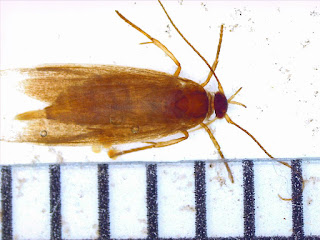When I arrived at Wilkes University in 2007, we had a collection of about 250 insects, arranged in orders in drawers. Unfortunately, none of the specimens had labels so many were tossed. Around 2011, we inherited hundreds of insects from Mike, a friend of the university that took care of the university and also a school teacher. These insects were also without any collection information and many were thrown out. Heart breaking but what is the value of a specimen without any data?
In the meantime, we were collecting arthropods as part of study of grassland restoration (see https://onlinelibrary.wiley.com/doi/full/10.1111/rec.12202), then as a study of the effects of grassland management on diversity in fifteen grasslands (accepted in Ecosphere). Those samples were sorted to order. Many were photographed and data were entered into Biota. I'm still trying to find the images - my worry is that the file was created by someone that graduated and no longer accessible. Lesson learned.
More recently, I became interested in the effects of prescribed burning on pollinators and food webs more largely. In the last two years, I must have collected, I'm estimating, about 10,000 insects and we have sorted about 4200 insects so far. There are another 20,000 insects that are still in jars, envelopes, etc. so be sorted. Yep, I have quite the work load ahead of me. I'm sending many samples off to be analyzed for the food web study and we are focusing on omnivores - because their trophic position can tell us about the productivity of a site.
I wanted to run some summary statistics to both create a benchmark for tracking progress of the collection and quality control. Simply by producing tables, I can catch spelling mistakes and other typos.
We had 529 collection events entered. That's a pitfall, sweep, or pollinator pan. We do have a few collection entries that are single bird captures and a blood and feather sample is part of the collection. Moving forward, a collection involving birds will be all birds captured at a site during one effort (mist-netting/box check). We also have a few plants - this is different from the plants in the herbarium. These are samples to be isotoped for the food web study. Whole plants will go into the herbarium but tissue samples go into our collection. Not sure if this is best practice but this is where I'm at.
Here's the summary of our collection
Entries
4241 entries
Megan O. entered 970 lines
Tyler S. entered 948 lines
Cally E. entered 586 lines
Becca K. entered 398 lines
There were about 10 other people that entered data - all less than 300 lines.
I entered 238 lines - wow, I have a lot to do to catch up (consider it takes 5 - 10 minutes per insect to enter).
Taxa
- 23 unknown phyla (this is an error - unless I really can't identify something to phylum)
- 2 annelids (worms)
- 4125 arthropods (no surprise there)
- 68 chordates (feather/blood, hair, scales)
- 16 flowering plant samples (should be many many more)
- 6 mollusks (all snails)
- 1 fern (a bracken fern, a common field fern)
Of the arthropods
- 185 spiders
- 88 collembola (springtails)
- 14 millipedes (this number seems really low but it's odd how few go into pitfalls compared to how many you see in the forest)
- 4 snails
- 3828 insects
- 3 Malacostraca (rolly-polly)
Of the insects
- 2 cockroaches (much much lower than expected)
- 428 Coleoptera (beetles)
- 1201 Diptera (flies)
- 574 Hemiptera (true bugs)
- 1239 Hymenoptera (bees, wasps, ants - most of these are ants and tiny wasps)
- 88 Lepidoptera (most were hand captures but also include a number of micromoths that are a few mm)
- 17 Odonata (dragonflies - all are hand captures)
- 138 Orthoptera (grasshoppers and crickets, mostly older samples from sweepnets)
- 50 mistakes (wrong orders listed with Insecta as the class, space added in front of the name or after)
- identified to species 320 (not awesome)
Moving forward
- add many more species identities
- fix all the errors
- send hundreds of samples off to be isotoped (~ 850 samples have isotope data)
- sort and enter thousands of insects!
I do need a bunch of https://www.forestry-suppliers.com/p/53598/52861/cornell-university-insect-cabinet-drawer. And time.. lots of time.


